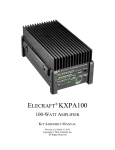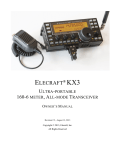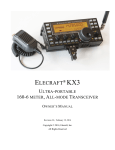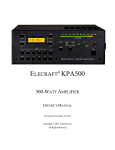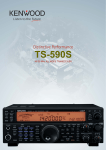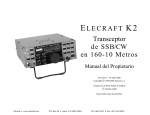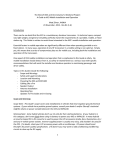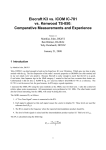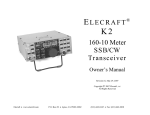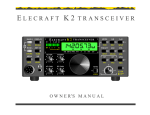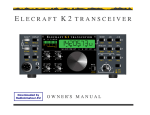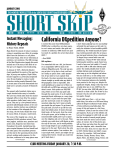Download ELECRAFT KXPA100 Owner`s manual
Transcript
ELECRAFT KXPA100 100-WATT AMPLIFIER OWNER’S MANUAL Revision A, November 18, 2013 Copyright © 2013, Elecraft, Inc. All Rights Reserved Contents Introduction ............................................................................................................................................................ 3 Customer Service and Support ............................................................................................................................. 4 In the Box ................................................................................................................................................................ 5 KXPA100 Amplifier and ATU ................................................................................................................................................5 Carrying Handle ............................................................................................................................................... 5 Supplied with KXPA100 .........................................................................................................................................................5 Serial Data Cable ............................................................................................................................................. 5 Fused DC Power Cable .................................................................................................................................... 6 Key Line Cable ................................................................................................................................................ 6 Optional Cables .....................................................................................................................................................................6 KX3 to KXPA100 Adapter Cable Set (KXPACBL) ....................................................................................... 6 Right Angle BNC to PL-259 RF Cable............................................................................................................ 7 CAT6 Cable ..................................................................................................................................................... 7 KXPA100 to KX3 Power Cable ...................................................................................................................... 7 Getting Started ....................................................................................................................................................... 8 Installation .............................................................................................................................................................. 9 Positioning the Amplifier .......................................................................................................................................................9 Preparing the DC Power Cable ...........................................................................................................................................10 Installing the Fuses......................................................................................................................................... 10 Connecting the Power Cable to the DC Supply ............................................................................................. 10 Connections to the Amplifier .............................................................................................................................. 11 Amplifier Connections using the KX3 to KXPA100 Adapter Cable .....................................................................................11 Amplifier Connections for Basic Operation .........................................................................................................................14 Operation .............................................................................................................................................................. 16 Front Panel Controls and Indicators ...................................................................................................................................16 Rear Panel Attenuator Switch ..............................................................................................................................................18 Operation with a KX3 Transceiver using the KX3 to KXPA100 Adapter Cable..................................................................19 Initial Settings Using the KX3 to KXPA100 Cable ....................................................................................... 19 Amplifier Operation Using the KX3 to KXPA100 Cable.............................................................................. 19 ATU Operation Using the KX3 to KXPA100 Cable ..................................................................................... 20 Basic Operation with any Transceiver .................................................................................................................................22 Initial Basic Operation Settings ..................................................................................................................... 22 Amplifier Basic Operation ............................................................................................................................. 22 ATU Basic Operation..................................................................................................................................... 23 Faults ...................................................................................................................................................................................25 2 Utility Program..................................................................................................................................................... 26 Starting the Utility Program ................................................................................................................................................26 Updating KXPA100 Firmware .............................................................................................................................................26 Forcing a Firmware Load ............................................................................................................................... 27 Monitoring through the Utility Program .............................................................................................................................27 Amplifier: ....................................................................................................................................................... 27 Faults .............................................................................................................................................................. 28 Antenna Tuner................................................................................................................................................ 29 Configuration Save and Restore ..........................................................................................................................................29 Updating KX3 Firmware .....................................................................................................................................................29 Specifications ........................................................................................................................................................ 30 KXPA100 Amplifier..............................................................................................................................................................30 KXAT00 Antenna Tuning Unit (ATU) ..................................................................................................................................30 Theory of Operation ............................................................................................................................................ 32 KXPA100 Amplifier..............................................................................................................................................................32 KXAT100 Antenna Tuning Unit (ATU) ................................................................................................................................33 ATU Memories .............................................................................................................................................. 33 Cable Schematics .................................................................................................................................................. 35 KX3-KPA100 Adapter Cable ...............................................................................................................................................35 Serial Interface Cable ..........................................................................................................................................................36 Elecraft manuals with color images may be downloaded from www.elecraft.com. 2 Key to Symbols, Abbreviations and Text Styles Important supplemental information – read carefully Operating tip LED Light Emitting Diode LCD Liquid Crystal Display ATU Antenna Tuning Unit TUNE AN T PA TUNE ANT 1 Tap switch function (hold switch for less than 1/2 second to activate) Hold switch function (hold switch for 1/2 sec. to activate) Menu text displayed on the KX3 LCD. Text printed on the equipment to identify connectors and controls or text displayed on your PC when running the Utility Program. CAUTION Follow the instructions under a Caution to avoid damage to the equipment. WARNING Follow the instructions under a Warning to avoid serious personal injury. 2 Introduction On behalf of our design team, we'd like to thank you for choosing the KXPA100 amplifier. At Elecraft, we know how rewarding low-power operation can be; that's why we offer a range of QRP transceivers optimized for portable and emergency communications. But there are times when higher power is needed to get the job done, and this is where the KXPA100 comes in. Whether you're using it with a KX3 or other low-power rig, this versatile, 100-W amplifier can automatically and silently boost your signal to overcome difficult band conditions. If you also have the KXAT100 module installed, you'll have the advantages of a wide-range automatic antenna tuner (ATU). The KXAT100 provides automatic retuning, instant recall of LC settings, and dual antenna jacks. When used with the KX3 and its amplifier control cable, the ATU's TUNE switch, ANT switch, and menu functions can all be controlled directly from the KX3. In any setting--fixed, mobile, or field--we hope you find the rugged, compact KXPA100 a valuable addition to your station. 73, Wayne, N6KR Eric, WA6HHQ 3 Customer Service and Support Technical Assistance You can send e-mail to [email protected] and we will respond quickly - typically the same day Monday through Friday. Telephone assistance is available from 9 A.M. to 5 P.M. Pacific time (weekdays only) at 831763-4211. Please use e-mail rather than calling when possible since this gives us a written record of the details of your problem and allows us to handle a larger number of requests each day. Repair / Alignment Service (We want to make sure everyone succeeds!) If necessary, you may return your Elecraft product to us for repair or alignment. (Note: We offer unlimited email and phone support to get your kit running, so please try that route first as we can usually help you find the problem quickly.) IMPORTANT: You must contact Elecraft before mailing your product to obtain authorization for the return, what address to ship it to and current information on repair fees and turnaround times. (Frequently we can determine the cause of your problem and save you the trouble of shipping it back to us.) Our repair location is different from our factory location in Aptos. We will give you the address to ship your kit to at the time of repair authorization. Packages shipped to Aptos without authorization will incur an additional shipping charge for reshipment from Aptos to our repair depot. Elecraft's 1-Year Limited Warranty This warranty is effective as of the date of first consumer purchase (or if shipped from factory, date product is shipped to customer). It covers both our kits and fully assembled products. For kits, before requesting warranty service, you should fully complete the assembly, carefully following all instructions in the manual. Who is covered: This warranty covers the original owner of the Elecraft product as disclosed to Elecraft at the time of order. Elecraft products transferred by the purchaser to a third party, either by sale, gift or other method, who is not disclosed to Elecraft at the time of original order, are not covered by this warranty. If the Elecraft product is being bought indirectly for a third party, the third party's name and address must be provided to Elecraft at time of order to insure warranty coverage. What is covered: During the first year after date of purchase, Elecraft will replace defective or missing parts free of charge (post-paid). We will also correct any malfunction to kits or assembled units caused by defective parts and materials. Purchaser pays inbound shipping to Elecraft for warranty repair, Elecraft will pay shipping to return the repaired equipment to you by UPS ground service or equivalent to the continental USA and Canada. Alaska, Hawaii and outside U.S. and Canada actual return shipping cost paid by owner. What is not covered: This warranty does not cover correction of kit assembly errors. It also does not cover misalignment; repair of damage caused by misuse, negligence, or builder modifications; or any performance malfunctions involving non-Elecraft accessory equipment. The use of acid-core solder, water-soluble flux solder, or any corrosive or conductive flux or solvent will void this warranty in its entirety. Also not covered is reimbursement for loss of use, inconvenience, customer assembly or alignment time, or cost of unauthorized service. Limitation of incidental or consequential damages: This warranty does not extend to non-Elecraft equipment or components used in conjunction with our products. Any such repair or replacement is the responsibility of the customer. Elecraft will not be liable for any special, indirect, incidental or consequential damages, including but not limited to any loss of business or profits. 4 In the Box Check the shipping box for the following contents. If you purchased your KXPA100 as a kit, refer to the Kit Assembly Manual included in the box to assemble the kit. KXPA100 Amplifier and ATU You will find your KXPA100 amplifier in the box, unless you assembled the kit version. The KXAT100 antenna tuning unit, if included, will be inside the same enclosure as the KXPA100. The cover photograph on this manual shows a KXPA100 amplifier with the optional KXAT100 antenna tuning unit installed. The bottom row of controls and indicators for SWR, mode and ATU functions are present only if you purchased the KXPA100 with the optional KXAT100 antenna tuning unit. Carrying Handle The KXPA100 has a strap handle on one side for ease in carrying the unit. When setting the unit down, place it on its four feet with the handle on the side Supplied with KXPA100 Serial Data Cable Connects the KXPA100 to your personal computer to upload updated firmware and provide other functions (see Utility Program, page 26 for details). A serial data cable that connects to your pc USB port is provided unless you specified a cable for an RS232 connector. 5 Fused DC Power Cable Connects the KXPA100 to your dc power supply. Both leads are fused with 25A fuses supplied (see Preparing the DC Power Cable, page 10) Key Line Cable Male to male RCA-type connector cable used for connecting the PA Key line to the driving transceiver in Basic Mode (see Amplifier Connections for Basic Operation, page 14 ) or for connecting the key line output on the Adapter Cable to an external high powered amplifier (see Amplifier Connections using the KX3 to KXPA100 Adapter Cable, page 11) Optional Cables KX3 to KXPA100 Adapter Cable Set (KXPACBL) This set of cables allows for the closest integration between an Elecraft KX3 transceiver and the KXPA100 amplifier and KXAT100 ATU (see Amplifier Connections using the KX3 to KXPA100 Adapter Cable, page 11 and Operation with a KX3 Transceiver using the KX3 to KXPA100 Adapter Cable, page 19.) 6 Right Angle BNC to PL-259 RF Cable CAT6 Cable KXPA100 to KX3 Power Cable 7 Getting Started The KXPA100 amplifier and KXAT100 antenna tuning unit (ATU) can be used with any HF and 6-meter transceiver except those operating between 26 and 28 MHz. For simplicity, “transceiver” is used throughout this manual to mean either a transceiver or a transmitter. The KXPA100 amplifier and KXAT100 antenna tuner may be installed and operated in two ways: 1. With an Elecraft KX3 transceiver connected using the optional KX3 to KXPA100 Adapter Cable (KXPACBL). This provides the best integration of the system, allowing you to control the KXPA100 amplifier and the KXAT100 ATU from the KX3. You do not need to access KXPA100 in normal operation. 2. Configured for basic operation with any 160-6 meter transceiver (including a KX3 if you don’t have the optional adapter cable). This requires that you position the amplifier so you have access to its controls and indicators. First, turn to Installation on page 9 to position the amplifier and connect the dc power cable. Next, connect cables to the amplifier: If you have a KX3 and the KX3 to KXPA100 Adapter Cable, refer to page 11. For any other installation refer to page 14. Now you are ready to get on the air. The amplifier and ATU front panel controls and indicators are described on page 16 For a KX3 connected with the adapter cable, refer to Operation with a KX3 Transceiver using the KX3 to KXPA100 Adapter Cable on page 19. For any other installation, refer to Basic Operation with any Transceiver on page 22. 8 Installation Positioning the Amplifier The KXPA100 amplifier may be mounted vertically or horizontally as shown in Figure 1. Four bushings are provided for attaching the amplifier to a bracket if needed. The bushings are threaded for 6-32 screws. Do not use screws that extend inside the amplifier more than 1/8” (3.2 mm). Be sure the location allows you to access both the front and rear panels of the amplifier. If you connect the amplifier using the KX3 to KXPA100 Adapter Cable as described on page 11, you won’t need access to the front panel in normal operation but being able to see the indicators may be useful for troubleshooting if something is not working properly. CAUTION Ensure air can flow freely along the fins as the amplifier warms up in use. Do not place anything on the fins that can restrict the air flow. Leave at least 3” (7.6 cm) clear above the fins and at least 1.5” (3.8 cm) clear along the sides. Figure 1. Orienting the Amplifier for Proper Cooling. 9 Preparing the DC Power Cable Installing the Fuses Both leads of the dc power cable are fused with 25 Ampere fuses. These fuses protect the cable from the dc supply to the KXPA100 from overheating in the event of a short circuit. Your cables may be supplied with the fuses already installed in the holders. Open each holder as shown in Figure 2 and install the fuse or to ensure that the fuse is installed. The fuse holder cover is a friction fit. To open, grip the cover and the base of the holder (connected to the wire) and pull them apart. The spade contacts on the fuse are a friction fit in the terminals inside the lower part of the holder. Fuses are not polarized. They can be inserted with the spade contacts oriented either way. Normally a fuse that has opened due to overload will show a broken or blackened area around the fusible link. It is possible for an overload to open the fusible link in such a way that it is not obvious. The opening may be so small that the fuse becomes intermittent, testing good when cold and interrupting power under normal current loads or after a short period of use. If in doubt after experiencing intermittent operation, replace the fuses. Check the fuses in both power leads. Figure 2. DC Power Cable Fuses. Connecting the Power Cable to the DC Supply You will need to supply and attach the appropriate terminals to connect to your dc supply. The black wire leading from the Anderson PowerPole® connector goes to the negative (-) supply terminal. To avoid confusion where the fuses are attached, the negative lead is covered with a length of black tubing near the end. Your KXPA100 will not turn on if the dc leads are not connected to your supply with the correct polarity. 10 Connections to the Amplifier Secure all cables to avoid placing strain on them. This is especially important when the amplifier is mounted vertically with the cables on the bottom or in mobile installations with significant vibration. If you are connecting the amplifier to your KX3 using the optional KX3 to KXPA100 Adapter Cable, connect the amplifier as described below under Amplifier Connections using the KX3 to KXPA100 Adapter Cable. If you are using the amplifier any other transceiver or not using the optional Adapter Cable with your KX3, connect the amplifier as described under Amplifier Connections for Basic Operation on page 14. Amplifier Connections using the KX3 to KXPA100 Adapter Cable Figure 3 shows the connections required. See the following text for details of each cable and its function. The adapter cable may be used only with a KX3 transceiver. If you have any other transceiver or a KX3 without the adapter cable turn to Basic Operation with any Transceiver on page 22. An amplifier with the optional KXAT100 antenna tuner is shown. If your amplifier does not have the antenna tuner option, you will have only one ANT connector. Otherwise there is no difference in the connections. These circled numbers in the following notes refer to the corresponding numbers on Figure 3. Ground Connection: Connect the station ground to the thumbscrew. A good station ground with short, direct leads connection each piece of equipment is important for consistent, reliable operation. DC Power Connection: CAUTION If the station power supply is energized, be sure the power switch on the front panel (see Figure 5 on page 16) is in the OFF position before proceeding. Connect the Anderson PowerPole® connector to either mating connector on the back of the amplifier. Red goes to red and black goes to black. Connect the other end to your power supply with the black wire connected to the negative (-) terminal. To avoid excessive voltage drop under full load, keep the lead length as short as possible. Also, connect the dc supply to the lower connector. It has a slightly more direct connection inside the KXPA100. The second PowerPole® connector on the amplifier is paralleled with the first. It can be used to extend power to other equipment such as the KX3 transceiver using the cable supplied as part of the optional KX3 to KXPA100 Adapter Cable set. If you experience excessive voltage drop due to the resistance of the power cable, you can use the second connector for a second parallel lead from your power supply. If used, the second power lead should be fused identically to the first at the power supply end of the cable. If you connect cables to both Anderson PowerPole® connectors, recommend you tie the two cables together with a cable tie. That will greatly increase the force needed to pull the cables out of the connectors on the amplifier. Notes Continued Following Figure 3. 11 Figure 3. Connecting the Amplifier to a KX3 Using the Optional Adapter Cable. 12 Personal Computer Interface Cable: All communications with both the KX3 transceiver and the KXPA100 amplifier take place through this cable. This cable is not required, but provides enhanced capability to operate the KXPA100 using the KXPA Utility program, for updating firmware in either the KXPA100 or KX3 and other functions (see Utility Program, page 26 for details.) Also, this cable provides communications between your PC and the KX3. You do not need to connect the KX3 to your computer. Simply load the KX3 Utility program, be sure you have the correct serial port selected, and your computer will find the KX3 as long as it is powered on. RF Signal Connection between the KX3 and KXPA100: Use a 50-ohm coaxial cable with a PL259 (UHF male) connector for the amplifier RF IN and a BNC male connector for the KX3. RF Connection to Antenna or Dummy Load: Normally a 50 ohm coaxial cable with a PL-259 (UHF Male) connector leading to a 100 watt dummy load or antenna. A direct connection to an antenna wire may be used here instead if it presents a low enough SWR or your KXPA100 is equipped with the optional KXAT100 ATU (antenna tuner).There will be only one ANT connector if you do not have the optional KXAT100 ATU. The other position will be filled with a plug. Adapter Cable Connection to the Amplifier: A 6-inch (15.2 cm) CAT 6 cable with RJ45 connectors is included with the KX3 to KXPA100 Adapter Cable set. If needed, the cable supplied may be replaced with a shielded CAT 6 cable up to 25 feet (7.6 meters) long. Key Line Connection to the KX3: The ring terminal on the 2.5 mm stereo plug on the Adapter Cable connects to the KX3 key line in the ACC2 connector. The KX3 grounds the key line while transmitting to enable the amplifier. Serial Data Connection to the KX3: 3.5 mm stereo plug on the Adapter Cable connects to the ACC1 connector. The KX3 passes band, frequency and command data to the amplifier via this connection. The KX3 turns the KXPA100 on and off and sends tuning commands to the KXAT100 ATU (if present). CAUTION Do not pull on the cables when they are plugged into the ACC1 or ACC2 connectors on the KX3. The cables are equipped with right-angle connectors to minimize strain, but rough handling can break the sockets in the KX3. General Purpose Input-Output (GPIO): 3.5 mm mono connector that provides access to the KX3 GPIO normally available at the ACC2 jack. See your KX3 Owner’s Manual, especially the ACC2 IO entry under Menu Functions, for details of the GPIO. Key Line Jack: RCA type female connector for the key line when the KXPA100 is used to drive a higher-power amplifier. PA Key Connector: Not used in this installation. The key line, which enables the amplifier during transmit, is included in the adapter cable. 13 Amplifier Connections for Basic Operation Figure 4 shows the connections to the amplifier when it is used with transceivers other than the KX3, or with a KX3 without the optional KX3-KXPA100 Adapter Cable. An amplifier with the optional KXAT100 antenna tuner is shown. If your amplifier does not have the antenna tuner option, you will have only one ANT connector. Otherwise there is no difference in the connections. The transceiver must have a key out connection that grounds the key line to enable the amplifier for transmitting. Otherwise you will need to provide a means for manually grounding this line. If the line is not grounded, RF from the transceiver is passed through without being amplified. See the notes on the following page for a description of each connection. Figure 4. KXPA100 Connections to Any Transceiver for Basic Operation 14 Ground Connection: Connect the station ground to the thumbscrew. A good station ground with short, direct leads connecting each piece of equipment is important for consistent, reliable operation. DC Power Connection: CAUTION: If the station power supply is energized, be sure the power switch on the front panel (see Figure 5 on page 16) is in the OFF position before proceeding. Connect the Anderson PowerPole® connector to either mating connector on the back of the amplifier. Red goes to red and black goes to black. Connect the other end to your power supply with the black wire connected to the negative (-) terminal. To avoid excessive voltage drop under full load, keep the lead length as short as you can. Also, connect the dc supply to the lower connector. It has a slightly more direct connection inside the KXPA100. The second PowerPole® connector on the amplifier is paralleled with the first. It can be used to extend power to other equipment such as the KX3 transceiver. If you experience excessive voltage drop due to the resistance of the power cable, you can use the second connector for a second parallel lead from your power supply. If used, the second power lead should be fused identically to the first at the power supply end of the cable. If you connect cables to both Anderson PowerPole® connectors, we recommend you tie the two cables together with a cable tie. That will greatly increase the force needed to pull the cables out of the connectors on the amplifier. Personal Computer Interface Cable: This cable is not required, but provides enhanced capability to operate the KXPA100 from your personal computer using the KXPA Utility program, for updating the KXPA100 firmware and other functions (see Utility Program, page 26 for details.) RF Signal Connection Between the Transceiver and KXPA100: 50-ohm coaxial cable with a PL259 (UHF male) connector for the amplifier RF IN and whatever connector type is required by the transceiver antenna output. RF Connection to Antenna or Dummy Load: Normally a 50 ohm coaxial cable with a PL-259 (UHF Male) connector leading to a 100 watt dummy load or antenna. A direct connection to an antenna wire may be used here instead if it presents a low enough SWR or your KXPA100 is equipped with the optional KXAT100 ATU (antenna tuner). There will be only one ANT connector if you do not have the optional KXAT100 ATU. The ANT 2 position will be filled with a plug. Key Line Connection to the Transceiver: The key line controls the amplifier. When grounded, it enables amplification for transmit. When not grounded, RF passes between the amplifier and antenna without amplification for receiving or for transmitting with the driving transceiver power only. The key line circuit must sink about 1 mA when grounded. Refer to the Owner’s manual for your transceiver to properly connect your key line. If you are using a KX3, the key line is on the ring of the 2.5mm ACC2 connector. For transceivers without a key line output the amplifier may be controlled manually using a foot switch or other switch to ground the key line to enable the amplifier. 15 Operation The location and function of each control and LED indicator are described below. Operating instructions for the amplifier when used with the KX3 and optional KX3 to KXPA100 Adapter Cable are on page 19. Operating instructions for the amplifier when used with any other transceiver or with a KX3 without the optional adapter cable are on page 22. CAUTION Ensure the amplifier is connected to a dummy load or antenna before attempting to transmit. A 50-ohm dummy load capable of handling 100 watts is recommended for initial testing. Front Panel Controls and Indicators The front panel controls and indicators are shown in Figure 5 and are described in the following text. Figure 5. Front Panel Controls and Indicators 16 Power Switch: Controls dc power to the KXPA100 amplifier and (if equipped) the KXAT100 ATU. Amplifier Status Indicators. Normal operation: POWER OUT (W) indicates the power being delivered by the amplifier. ATT is on when the input attenuator is switched in (see Rear Panel Attenuator Switch below). TX is on when the key line is grounded by the driving transceiver, enabling the amplifier. The amplifier is disabled if the TX LED is off. Only the power delivered by the driving transceiver is passed through and indicated on the POWER OUT LEDs. ON indicates when dc power is applied and the Power switch is ON. Fault lights if a fault condition occurs. Normal operation is suspended and one of the LEDs to the left of the Fault LED also lights. See Faults on page 25 for a complete description of the faults and how to correct them. The following front panel controls and indicators are present only if the amplifier is equipped with the optional KXAT100 antenna tuning unit. See page 20 for complete ATU operating instructions. Antenna Tuning Unit status indicators: SWR: Indicates the Standing Wave Ratio of the load presented to the amplifier by the KXAT100 tuner. ANT: Indicates the rear panel antenna connector selected (1 or 2). MODE: Indicates the ATU operating mode Byp (bypass), Man (manual), Auto (automatic) TUNE switch: Tap T U N E to start an ATU tune operation or to ready the ATU to perform a tune operation when RF drive is applied (see ATU Operation, page 20). Hold AN T to select the desired antenna. MODE switch: Selects the desired ATU mode (bypass, manual or automatic). See ATU Operation, page 20. 17 Rear Panel Attenuator Switch In addition to the front panel controls and indicators, there is a 3 dB ATTEN switch on the rear panel (see Figure 6). This switch controls an attenuator at the amplifier input that reduces the drive power by half when needed. In the OUT/AUTO position it operates automatically, providing no attenuation if the driving transceiver is delivering normal drive to the amplifier. If the driving power exceeds 8 watts, the attenuator switches in automatically for several seconds to protect the amplifier from unintentional, temporary excess RF drive, but will switch out again automatically. The IN position inserts 3dB attenuation at all times. Figure 6. Attenuator Switch on Rear Panel. 18 Operation with a KX3 Transceiver using the KX3 to KXPA100 Adapter Cable This provides the most efficient integration of the KX3 transceiver, the KXPA100 amplifier and the KXAT100 Antenna Tuning Unit (ATU). Normally you will not need to touch the KXPA100 amplifier. All operation takes place at the KX3 front panel similar to operating the KX3 by itself. Connections: Your KX3 must be connected to the KXPA100 amplifier with the KX3 to KXPA100 Adapter Cable as shown in Figure 3 on page 12. Refer to Operation with any Transceiver on page 19 if you are using a transceiver other than the KX3, or a KX3 without the adapter cable. Firmware: Your KX3 must be equipped with firmware level 1.74 or later. To check the firmware level, turn your KX3 on and hold M E N U . Turn the OFS knob to FW REVS and read the firmware level on the upper part of the K3 LCD. If needed, update your firmware as described in your KX3 Owner’s Manual. Fault Conditions: If at any time PA FLT is displayed on the KX3 LCD or the Fault LED on the KXPA100 front panel lights, refer to Faults on page 25 for descriptions and remedies. Initial Settings Using the KX3 to KXPA100 Cable 1. Apply dc power to the KXPA100 amplifier and KX3. 2. Leave the amplifier ON/OFF switch in the OFF position. Power to the amplifier will be controlled at the KX3. 3. At the KX3, hold M E N U and turn the OFS knob to PA MODE. 4. Turn the VFO A knob to On. The KXPA100 amplifier ON and ATT LEDs will light. If the KXPA100 is equipped with the optional KXAT100 ATU, the ANT 1 or ANT 2 and MODE Man LEDs will also light. 5. Connect a 50-ohm dummy load or antenna to the KXPA100 active ANT connector indicated by the lighted ANT 1 or ANT 2 LED. Amplifier Operation Using the KX3 to KXPA100 Cable Operation is almost identical to operating the KX3 without the amplifier. The internal KXAT3 ATU, if installed, is automatically bypassed when you switched the KX3 menu to PA MODE On step 4 above. The amplifier presents a low SWR to the KX3 on all bands. Antenna Selection: If the KXPA100 is equipped with the optional ATU, hold the KX3 AN T switch to toggle the between the ANT 1 and ANT 2 antenna connectors on the KXPA100. The selected antenna is displayed on the KX3 LCD when the selection is changed, ANT.x 1 or ANT.x 2, and on the front panel LEDs on the KXPA100. Be sure you have an antenna or dummy load connected to the active antenna port before transmitting. 19 Power Control: The KX3 PWR control now has a range from 0 to 100 watts. The KX3 monitors the amplifier power output through the Adapter Cable and adjusts the RF drive automatically to produce the output power from the amplifier that you selected with the KX3 PWR control. At low power settings, the KX3 does not ground the Key Line so the amplifier passes the RF through without amplification. At settings above 10 watts, the kX3 automatically ground the key line to enable the amplifier. Band Switching: The KXPA100 amplifier automatically follows band changes at the KX3 using data passed through the KX3 to KXPA100 Adapter Cable. The amplifier also senses the frequency of the RF from the KX3. If the band data is missing or does not agree with the frequency sensed for any reason, the amplifier switches according to the frequency sensed. Monitoring: You can monitor the temperature of the KXPA100 power transistor heat sink from the KX3. With the PWR control set high enough to engage the amplifier (see Power Control, above) tap D I S P and rotate the OFS knob to PA.X followed by the temperature in Celsius. The KXPA100 selfprotection circuits will declare a fault condition and switch the amplifier into bypass if the temperature rises too high (see Faults on page 25.) The KX3’s internal power amplifier temperature can be displayed by turning the PWR control below the level where the KXPA is switched in. The LCD will now display PA.I followed by the temperature in Celsius. DC Power Control: The KXPA100 amplifier switches off automatically a few seconds after the KX3 is turned off provided the KXPA100 front panel OFF ON switch is OFF. o To turn the KXPA100 off at the KX3: Hold M E N U Turn the OFS knob to PA MODE. Turn the VFO A knob to OFF. o The KXPA100 amplifier will switch off and can be turned on again by reversing the process and turning the VFO A knob to On. While off, the amplifier passes signals through to the ANT 1 connector. o The KXPA100 front panel OFF/ON switch will turn the amplifier on independent of the menu setting at the KX3 or whether the KX3 is on. ATU Operation Using the KX3 to KXPA100 Cable If the KXPA100 is equipped with the optional KXAT100 ATU, it is controlled from the KX3 using the same controls normally used to control the KX3’s internal ATU. The KX3’s internal ATU was automatically bypassed when you switched the KX3 menu to PA MODE in the Initial Settings, above. Enabling PA MODE and bypassing the KX3’s internal ATU also bypasses the tunable broadcast band (BCB) filter in the KXAT3 ATU. If you want to tune the broadcast band using this filter, first turn PA MODE off in the KX3 Menu. 20 ATU Modes: You can select the ATU operating mode from the KX3. Hold M E N U , turn the OFS knob to ATU.x MD and turn the VFO A knob to select the desired mode: bypass, manual, or auto. The KXPA100 front panel LEDs will change to indicate the mode selected: Bypass (Byp) Mode: The ATU matching network components are bypassed and the output of the amplifier is routed directly to the selected antenna connector (ANT 1 or ANT 2). Manual (Man) Mode: In this mode, the KXAT100 ATU behaves in the same way as the KX3’s internal KXAT3 ATU option. When RF is applied the ATU first checks to determine if there is an acceptable tuning solution in memory for that frequency. If not, a tune operation must be launched manually. The tuning solution is stored in memory and associated with the antenna connector used, so you can have a tuning solution in memory for ANT 1 and a different solution for the same frequency in ANT 2 to support a different antenna. Automatic (Auto) Mode: When RF is applied, the ATU first checks to determine if there is a tuning solution in memory that will result in an SWR of 1.8:1 or less. If not, the ATU automatically begins a full search for the optimum tuning solution. The tuning solution is stored in memory and associated with the antenna connector used, so you can have a tuning solution in memory for ANT 1 and a different solution for the same frequency in ANT 2 to support a different antenna. ATU Tuning: Tap AT U T U N E on the KX3 to initiate a tune cycle at the amplifier. If the ATU was in bypass mode, it will automatically switch to manual and the KX3 will supply RF drive while the ATU performs a tune operation. The KXPA100’s 25 LED under POWER OUT (W) blinks while the tuning operation is taking place. The SWR is displayed on the KX3 LCD and on the KXPA100 front panel LEDs. The ATU automatically stores the tuning solution in memory. If you are unhappy with the SWR displayed after a tune operation, tap AT U T U N E again within five seconds. The ATU will do a second tune operation using smaller steps in the inductance and capacitance values. This process takes longer, but may result in a lower SWR. ATU Memories: The ATU has a large number of memory locations to provide storage for tuning solutions at frequencies from 1.5 MHz to 60 MHz. (See Theory of Operation on page 30 for details of the frequency segments.) A separate set of memory locations is provided to store tuning solutions for each antenna connector. When you change bands, the KX3 returns to the last frequency used on that band. If a corresponding tuning solution had been previously stored for that frequency, it is recalled from memory so the KXAT100 is ready to transmit immediately. The tuning solution is also recalled if you use direct frequency entry or recall a frequency from memory at the KX3. When tuning across a band, the ATU will retrieve the tuning solution for each frequency when you transmit, assuming one had been stored previously. The amplifier is inhibited for a fraction of a second the first time you transmit while this occurs. If you wish to QSY as quickly as possible to various frequencies without going through a tune operation, you can prepare the ATU by performing a tune operation on frequencies across each band. That will store the tuning solution so the KXPA100 will be ready in an instant without retuning when you return to that frequency. How many frequencies you will need to perform a tune operation on so the SWR is acceptably low on all frequencies depends upon the band and your antenna. Of course, this happens automatically in normal operation when you transmit for the first time on a frequency if the KXAT100 is in Auto mode. Doing it in advance simply avoids any delay for a tune operation the first time you transmit on a frequency. 21 Clearing ATU Memories: At the KX3, hold M E N U , and turn the OFS knob to ATU.x MD. Hold C L R (the OFS knob). MEM CLR will appear on the KX3 LCD while the ATU memories are being cleared. Clearing ATU memories is useful when changing to a new antenna to ensure the ATU stores new tuning solutions rather than use previous tuning solutions that might not be optimum. Basic Operation with any Transceiver Connections: The following instructions assume that your transceiver is connected to the KXPA100 amplifier as shown in Figure 4 on page 14. If you are using a KX3 with the KX3 to KXPA100 Adapter Cable connected as shown in Figure 3 on page 12, refer to Operation with the KX3 using the KX3 to KXPA100 Adapter Cable on page 19. Fault Conditions: If the Fault LED on the KXPA100 front panel lights, refer to Faults on page 25 for a description and remedy. Initial Basic Operation Settings On the KXPA100, set the 3 dB ATTEN. switch as follows: o Set the switch to OUT/AUTO if the driving transceiver is not capable of more than 5 watts output o Set the 3 dB ATTEN switch to IN when using the amplifier with any other transceiver capable of more than 5 watts output. Never apply more than 10 watts of RF drive to the KXPA100 at any time, even with the 3 dB ATTEN switch set to IN. Switch the KXPA100 OFF/ON switch to ON. The ON LED will light. The ATT LED will light if you have the 3 dB ATTEN switch set to IN. Connect a 50-ohm dummy load or antenna feed line that presents an SWR of less than 1.5:1 to the active KXPA100 ANT connector. If you have the optional KXAT100 ATU, the ANT 1 or ANT 2 LED will light indicating which antenna connector is active and the Man MODE LED will light. If you do not have the KXAT100 ATU installed use the ANT 1 connector. Operation of the ATU is covered after confirming initial amplifier tests. Amplifier Basic Operation Apply about 2 watts of RF drive to the KXPA100: Transmit Mode: The TX LED on the amplifier front panel will light indicating that it is in transmit mode. (If the LED does not light, the amplifier remains in receive mode and the RF drive simply passes through. Check the KEY line connections and make sure your transceiver is pulling the KEY line to ground on transmit.) Band Switching: The amplifier senses the frequency of the RF drive and automatically changes to the correct band. 22 If you have a low SWR load attached to the amplifier you may increase the drive to obtain the desired power output (100 watts maximum). If you have the KXAT100 ATU and need to use it to reduce the load SWR, do so as described below before increasing power. Power Output Monitoring: The POWER OUT (W) LEDs light to indicate the power output from the amplifier. These LEDs light in from left to right as a bar of light. For example, 70 watts output is indicated by the LEDs under 25, 50, 60 and 70 being lit. The output of power amplifiers typically vary ±1 dB for a given power input. For example, the amplifier may provide anywhere between 80 and 120 watts output for 5 watts of drive and may vary from band to band. This is typical. Never exceed 10 watts of RF drive to the amplifier at any time. ATU Basic Operation ATU Modes: The ATU modes are selected by tapping the M O D E switch. Bypass (Byp) Mode: The ATU matching network components are bypassed and the output of the amplifier is routed directly to the selected antenna connector (ANT 1 or ANT 2). Manual (Man) Mode: When RF is applied the ATU first checks to determine if there is an acceptable tuning solution in memory for that frequency. If not, a tune operation must be launched manually. The tuning solution is stored in memory and associated with the antenna connector used, so you can have a tuning solution in memory for ANT 1 and a different solution for the same frequency in ANT 2 to support a different antenna. Automatic (Auto) Mode: When RF is applied, the ATU first checks to determine if there is a tuning solution in memory that will result in an SWR of 1.8:1 or less. If not, the ATU automatically begins a full search for the optimum tuning solution. The tuning solution is stored in memory and associated with the antenna connector used, so you can have a tuning solution in memory for ANT 1 and a different solution for the same frequency in ANT 2 to support a different antenna. Preparing to Tune: With the amplifier on, tap the T U N E switch. The 25 LED under POWER OUT (W) will start blinking indicating that the ATU is ready to perform a tune operation. If the ATU MODE was in Byp (bypass) it will switch automatically to Man (manual) mode. The tune operation can be done in either Man or Auto (automatic) mode. Tap T U N E a second time if you wish to cancel the tune operation Tuning: Apply 5 watts from the driving transceiver. You will hear relays click as the ATU finds the best match and stop when it is done. The 25 LED will continue blinking throughout the tuning operation and stop when it is completed. The resulting SWR will be displayed. The SWR is displayed in the same way as the power output. For example, if the final SWR is 1.5:1 the 1, 1.2 and 1.5 LEDs will be lit. If you are not happy with the SWR, tap the T U N E switch again within 5 seconds. The ATU will do a second tune operation using smaller steps in the inductance and capacitance values. This process takes longer, but may result in a lower SWR. 23 You may launch a tune operation at any time while RF is applied. The tune operation will start immediately if RF is present when you tap T U N E or it will start when you apply RF after tapping T U N E . The amplifier is inhibited during a tune operation, so only the RF drive from the transceiver will be present at the ATU and antenna connector until the tune operation is completed. ATU Memories: The tuning solutions are stored in memory. When you return to a frequency again and transmit, the amplifier senses the frequency and the ATU will switch to the tuning solution in memory. Assuming you have not changed the antenna, the ATU will be ready to transmit almost instantaneously. The ATU has a large number of memory locations to store tuning solutions for many frequencies across the range of 1.5 to 60 MHz. Also, a separate set of memory locations is provided for each antenna connector. See Theory of Operation on page 30 for details. ATU memories may be cleared using the Utility program (see page 26). If you wish to QSY as quickly as possible to various frequencies without going through a tune operation, you can prepare the ATU by performing a tune operation on frequencies across each band. That will store the tuning solution so the KXPA100 will be ready in an instant without retuning when you return to that frequency. How many frequencies you will need to perform a tune operation on so the SWR is acceptably low on all frequencies depends upon the band and your antenna. Of course, this happens automatically in normal operation when you transmit for the first time on a frequency if the KXAT100 is in Auto mode. Doing it in advance simply avoids any delay for a tune operation the first time you transmit on a frequency. 24 Faults Faults occur to protect the amplifier and ATU if a dangerous, abnormal condition occurs. Normal KXPA100 amplifier or KXAT100 ATU operation is suspended until the fault condition is corrected. Fault conditions are indicated at the KXPA100 by the Fault LED lighting along with one of the LED’s to the left, shown in Figure 5 on page 16). If the KXPA100 is being used with an Elecraft KX3 transceiver connected with the KX3 to KXPA100 Adapter Cable, the fault condition will be displayed on the KX3 LCD as well. The fault will clear automatically after a delay of about 8 seconds when the condition causing it is corrected. After clearing the fault, the message will remain on the KX3 LCD until any key is pressed. LED KX3 MSG DESCRIPTION Ant Err Occurs if a high SWR is presented by the antenna with sufficient RF power output to harm the amplifier or ATU. If your KXPA100 has the ATU installed, be sure you selected the correct antenna and perform a tune operation (see page 20 or page 23 as applicable). If an ATU tune operation won’t correct the error, you will need to make appropriate changes to your antenna. Pin Hi P In Excessive RF drive to the KXPA100. Reduce the RF drive level. At moderately excessive drive the 3 dB attenuator is switched in automatically. The ATT LED will blink while the attenuator is switched in. It will switch out again after a brief delay. If the RF drive causes the attenuator to switch in and out, place the rear-panel 3 dB ATTEN switch to IN and increase drive as necessary up to a maximum of 10 watts. Po Hi P Out Temp Hi T SWR RF output from the amplifier is excessive. Reduce the RF drive level. Temperature of the amplifier final transistor heat sink is too high. Reduce the power output from the amplifier or reduce the antenna SWR. I HI Cur Excessive dc current drawn by the final amplifier. Normally occurs when the SWR presented by the antenna is too high. Reduce the power or the SWR. Be sure your RF output is not over 100 watts. If the ATU is installed, perform a tune operation to reduce the SWR. If not, adjust your antenna as needed to reduce the SWR or reduce the RF output power. Sys Fault n n is a fault code letter. See Faults on page 28 for a list of the faults. Com (none) Normally blinks during a firmware load. If not blinking, something has interrupted the firmware load. 25 Utility Program To use the Utility Program you will need: A personal computer. The KXPA Utility Program available free from Elecraft at www.elecraft.com. The serial interface cable supplied with your KXPA100 Starting the Utility Program Connect your computer to the KXPA100 using the supplied cable. Connect the end with the mini-plug to the RS-232 (PC) connector on the KXPA100 and the other end to your computer, normally to a USB port. Load the KXPA Utility Program Click on the Port tab and select the port your computer is using to communicate with the KXPA100. If you have trouble finding the correct port, check the troubleshooting help file in the Utility Program for a process to identify the correct one. Click on Test Communications button and, if you selected the correct port and everything else is working correctly, you will see a pop-up window stating that the utility is communicating with the KXPA100. Updating KXPA100 Firmware If you are using the KXPA100 with an Elecraft KX3 transceiver connected via the KX3 to KXPA100 Adapter Cable as shown in Figure 3 on page 12, you can use the KX3 utility through the same connection to the KXPA100. Simply load the KX3 utility program, select the active com port and it will find the KX3. Although your KXPA100 was shipped with the current firmware installed, from time to time updated and improved firmware may become available. Updated firmware may be obtained in two ways. 1. Click on Firmware tab and then the Click on Copy Firmware Files from Elecraft to download the latest production released firmware or, 2. Download the new file from the Elecraft web site manually and place it in a local folder, then click on Browse… to locate the folder on your computer. This is the way to access the latest Beta firmware available from Elecraft. To update firmware, start the KXPA Utility Program as described above and, click on the Send Firmware to the KXPA100 button to start the transfer. Follow any on-screen instructions. Be sure to check the notes supplied with the new firmware. They may include changes that affect the instructions in this manual. 26 If you don’t have Internet access, you can obtain a firmware upgrade on CD. If you don't have a computer, you can send your KXPA100 to Elecraft to be upgraded. See Customer Service and Support, page 4. Forcing a Firmware Load If an error condition occurs that prevents a firmware load, you can force a load as follows. Of course, this presumes there is not failure in your PC or the KXPA100 hardware. Switch the KXPA100 off. If you are using the KXPA100 in Basic mode, you can do this with the front panel OFF ON switch. If you are using the KXPA100 with a KX3 connected by the KX3-KXPA100 Adapter cable, you will need to switch the KX3 off. Exit and restart the KXPA Utility program (or click close on the Port tab and then test communications.) Click SEND FIRMWARE TO KXPA100 button. Turn the KXPA100 on again when a window appears in the KXPA Utility instructing you to do so. Monitoring through the Utility Program Start the KXPA Utility and click in the Operate tab to monitor the amplifier and ATU operation and command an ATU tune operation. Amplifier Input Power: The RF drive power received from the transceiver. Forward Power: The forward power measured by the internal SWR bridge. Reflected Power: The reflected power measured by the internal SWR bridge. Last SWR: The standing wave ratio (SWR) measured by the internal SWR bridge during the last transmission. Frequency: The driving RF signal frequency measured by the amplifier. This is used by the amplifier to select the correct band and over-rides any other input such as the band data from a KX3 connected through the KX3 to KXPA100 Adapter Cable. Band: The band the amplifier is switched to using the above frequency data. Drain Current: The current in amperes drawn by the amplifier transistors at the current or most recent transmission. Supply Voltage: The power supply voltage measured internally at the amplifier. Dissipated Power: The amount of power dissipated as heat by the power transistors. When the amplifier is connected to a low SWR load and delivering its rated 100 watts output, this will be roughly equal to the Forward Power reported indicating the maximum efficiency of about 50%. However, when the amplifier is feeding a higher SWR load or is run at lower powers, the dissipated power will rise relative to the output power indicating that the amplifier is operating below optimum efficiency. 27 Attenuator radio button: Click to switch the attenuator in (check appears) or out (no check). This works only if the 3 dB ATTEN switch on the KXPA100 is in the OUT/AUTO position. The radio button cannot change the attenuator state if the 3 dB ATTEN switch on the KXPA100 is in the IN position. When the KXPA100 is used with a KX3 transceiver connected through the KX3 to KXPA100 Adapter Cable, the attenuator is switched in automatically at all times. When the KXPA100 is used in basic operation, the attenuator will switch in automatically when the RF drive from the transceiver exceeds 8 watts (see Faults on page 25). Faults Faults occur to protect the amplifier and ATU if a dangerous, abnormal condition occurs. Normal KXPA100 amplifier or KXAT100 ATU operation is suspended until the fault condition is corrected. If a fault occurs, a plain text description will appear in the window. Faults will clear in 8 seconds after the condition causing the fault is corrected. Click on CLEAR to reset the fault immediately without waiting the full 8 seconds. Code Display Description Detail N NO FAULT Not a fault Number of times KXPA100 turned on since last fault A NO MATCH KXAT100 Antenna tuner was unable to find a match for the antenna's impedance SWR C HI CURRENT PA drain current exceeds the permitted limit Amperes D HI DISSIPATION PA is dissipating too much power as heat. Dissipated power is input supply voltage times PA drain current less output power. Watts H HI SUPPLY VOLTAGE Input dc supply voltage too high Volts L LO SUPPLY VOLTAGE Input dc supply voltage too low. Volts P HI FORWARD POWER RF output (forward) power exceeds the permitted maximum Watts R HI REFLECTED POWER RF reflected (reverse) power exceeds the permitted maximum Watts S HI SWR Antenna SWR exceeds the permitted maximum and ATU is absent or is not tuned for the frequency used. SWR T HI TEMPERATURE PA heat sink temperature exceeds allowed limit Degrees C 28 Antenna Tuner For those KXPA100s equipped with the optional KXAT100 ATU: Mode: Indicates current ATU mode. Click on radio button to change mode. Antenna: Indicates active antenna connector. Click on radio button to change antennas. Capacitance pF and Inductance nH: Indicates values of capacitance and inductance switched in for the current tuning solution. The values of capacitance and inductance can be adjusted manually using the up and down arrows next to each window or by clicking on the radio button next to each capacitor or inductor value. See Theory of Operation on page 30 for more details about the ATU circuit. Tune: Click to start a tune operation. If sufficient RF drive is not present, the ATU will perform a tune operation the next time sufficient RF is present. Click Tune again to cancel the tune operation. Configuration Save and Restore Click on the Configuration tab and click on the Save KXPA Configuration to save or Restore KXPA Configuration restore a previously saved configuration. The configuration data includes the tuning solutions for each antenna connector. Updating KX3 Firmware If you have a KX3 connected to the KXPA100 through the Adapter Cable, the way in which the KX3 controls the KXPA100 power may interrupt a firmware load to the KX3. Do one of the following to ensure the KXPA100 does not interfere with updating your KX3 firmware: Be sure the KXPA100 OFF ON switch is OFF and at the KX3 turn the PA Mode off so the KX3 will no longer attempt to control the KXPA100 power. To turn the PA Mode off, hold M E N U ,turn the OFS knob to PA MODE and turn the VFO A knob to OFF . Disconnect DC power from the KXPA100. At the KX3, disconnect the Adapter Cable and connect your pc directly to the KX3 at the ACC1 connector. 29 Specifications KXPA100 Amplifier Frequency Range Amateur Bands from 1.8 to 29.7 MHz and 50 to 54 MHz Supply Voltage and Current 12-15 Vdc (13.8 V nominal), at least 24 A peak capacity. About 1 mA parasitic drain current whenever dc power is connected. Power Output Max.100 watts at 13.8 V, 1.8 to 29.7 MHz and 80 watts 50-54 MHz PEP CW/SSB/DATA, ± 1 dB* Duty Cycle at 100 W Output RTTY/Digital/FM, 60 seconds continuous carrier. 100 watts continuous transmission on CW/SSB with a 50% duty cycle keying/modulation waveform. Thermally protected. Drive Power 3.5 to 7 watts, typical, for 100 W ± 1 dB output*. Input VSWR 1.5:1 or less. Metering Front Panel LEDs: Power Out, Attenuator, Transmit Key, Power On. If equipped with optional ATU: SWR, Antenna connector selected, ATU mode. Heat Sink Temperature 60 °C, maximum Key In +5 Vdc open circuit on receive, closed to ground on transmit (1 mA maximum). Efficiency About 50% at 100 watts output. Weight 5 lb 5oz (2.42 kg) including ATU. Size See Figure 7, page 31 * Maximum power output, as well as the drive power to reach a given power output, both vary per-band. Power output available may be reduced if the load SWR is high or supply voltage is low. The amplifier will protect itself from excessively high input or output power via the 3-dB attenuator or, if necessary, by dropping into bypass mode. KXAT00 Antenna Tuning Unit (ATU) Autotune Power 5 Watts. The KXPA100 amplifier is bypassed during a tuning operation so only the drive power from the transceiver is used for tuning. Typical Matching Range SWR as high as 10:1 at 100 watts; SWR as high as 20:1 at 10 watts. 30 Figure 7. Overall Dimensions. 31 Theory of Operation KXPA100 Amplifier Figure 1 is a simplified block diagram of the amplifier. Figure 8. KXPA100 Amplifier Simplified Block Diagram. The Transmit-Receive (TR) switch routes the RF input and outputs as needed: In receive mode (or when the amplifier is turned off) the RF input is routed to the RF output, passing only through the SWR Bridge. When the amplifier is used with a KX3 connected via the KX3 to KXPA100 Adapter Cable, the RF input is routed directly to the RF output at low power settings when the amplifier is not needed. In transmit the RF input is routed to the Power Amplifier (PA) module, and the RF from the Low Pass Filter bank is routed to the SWR Bridge. The Power Amplifier module amplifies the RF with two RD100HHF1 power MOSFETs. The Low Pass Filter Bank contains low pass filters to suppress harmonic energy. Control logic uses a firmware programmed MCU to control and monitor the amplifier operation: When a key line low is sensed, the amplifier is switched into transmit mode provided no fault conditions are present, the input signal is not in the 26 to 28 MHz range and an ATU tune operation is not underway. When RF is present at the input, the frequency of the signal is measured and the correct low pass filter is switched into the signal path. When the amplifier is connected to an Elecraft KX3 through the KX3 to KXPA100 Adapter Cable, the logic receives band data from the KX3 and switches in the correct low pass filter. This provides a small speed advantage in rapid band changes since it is not necessary to detect the frequency of the RF drive before switching in the proper filter. However, the RF frequency sensing takes priority if it does not agree with the band data to avoid transmitting with the incorrect filter selected. The 3 dB attenuator is automatically switched in when the RF drive power exceeds 8 watts. When a fault condition is detected the TR switch is inhibited so no RF power reaches the PA module unless the applied RF drive is so high it may damage the TR switch. In that case the amplifier is switched into bypass so no RF flows through the TR switch. 32 KXAT100 Antenna Tuning Unit (ATU) Figure 9 is a simplified block diagram of the ATU. Figure 9. KXAT100 Antenna Tuning Unit Simplified Block Diagram. The function of the ATU is to convert the impedance seen at the antenna connector to a 50 ohm non-reactive load for the amplifier or driving transceiver as measured by the standing wave ratio (SWR) bridge at the amplifier TR switch output. The same control logic that controls the amplifier controls all of the ATU functions. The ATU uses an “L” matching network with series inductance and shunt capacitance. Combinations of eight capacitors and eight inductors are switched in by relays to provide up to 2624 pF of capacitance or up to 17370 nH of inductance. An algorithm switches through the inductors and capacitors and chooses whether the capacitors are placed on the transmit or antenna side of the inductors to arrive at a tuning solution for the current operating frequency. The Amplifier circuit is kept in receive (RF routed through the TR switch but not the PA module) to protect the relays while they are switching. ATU Memories To facilitate very rapid frequency changes, tuning solutions are stored in memory and recalled when returning to that frequency. They will be recalled almost instantly when returning to that frequency later. The entire spectrum from 1.8 through 60 MHz is divided into frequency segments and tuning information is stored for each segment in which you have successfully completed a tune operation. When starting a tune operation for a frequency segment that has no previously stored tuning solution, the ATU logic first tries the settings in the nearest frequency segment that has tuning data. 33 Since retuning is normally required over a narrower frequency range on the lower frequencies to maintain a low SWR, the lower frequencies have narrower segments assigned as follows: Below 3 MHz the segments are 10 kHz wide. From 3 MHz through 26 MHz the segments are 20 kHz wide. From 26 MHz to 38 MHz the segments are 100 kHz wide. From 38 MHz to 60 MHz the segments are 200 kHz wide. The ATU also stores the antenna connector that you selected for each band. 34 Cable Schematics KX3-KPA100 Adapter Cable The adapter cable provides efficient integration of the KX3 transceiver, the KXPA100 amplifier and the KXAT100 Antenna Tuning Unit (ATU). It is available from Elecraft as part of an adapter cable set (see KX3 to KXPA100 Adapter Cable Set (KXPACBL) on page 6). The 3.5 mm connector plugs into the ACC1 jack on the KX3, and the 2.5 mm connector plugs into the ACC2 jack on the KX3. A CAT6 cable connects the RJ45 connector to the CONTROL jack on the KXPA100. See Amplifier Connections using the KX3 to KXPA100 Adapter Cable on page 11 for details about using the Adapter Cable. 35 Serial Interface Cable The KXSER interface cable is provided as an option to the KXUSB interface cable for those who have a conventional RS232 port on their computers. If you chose the KXUSB cable when you ordered your KXPA100, you can purchase the KXSER cable from Elecraft or make one yourself. Figure 10 is a schematic diagram of the cable. A kit of parts to fabricate a 6-foot (1.8 meter) serial interface cable is available from Elecraft; Order W1SERKT. Figure 10. Serial Interface Cable Schematic. 36







































